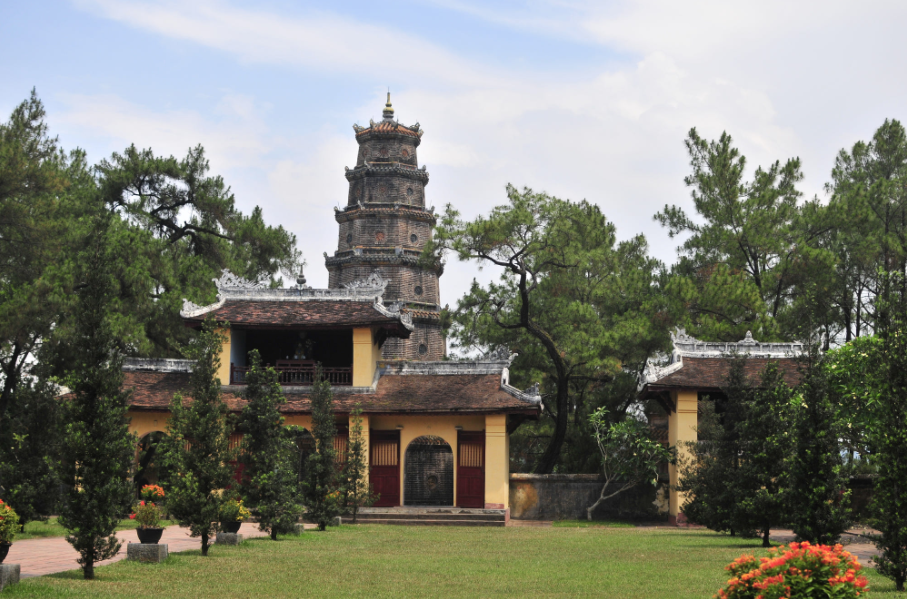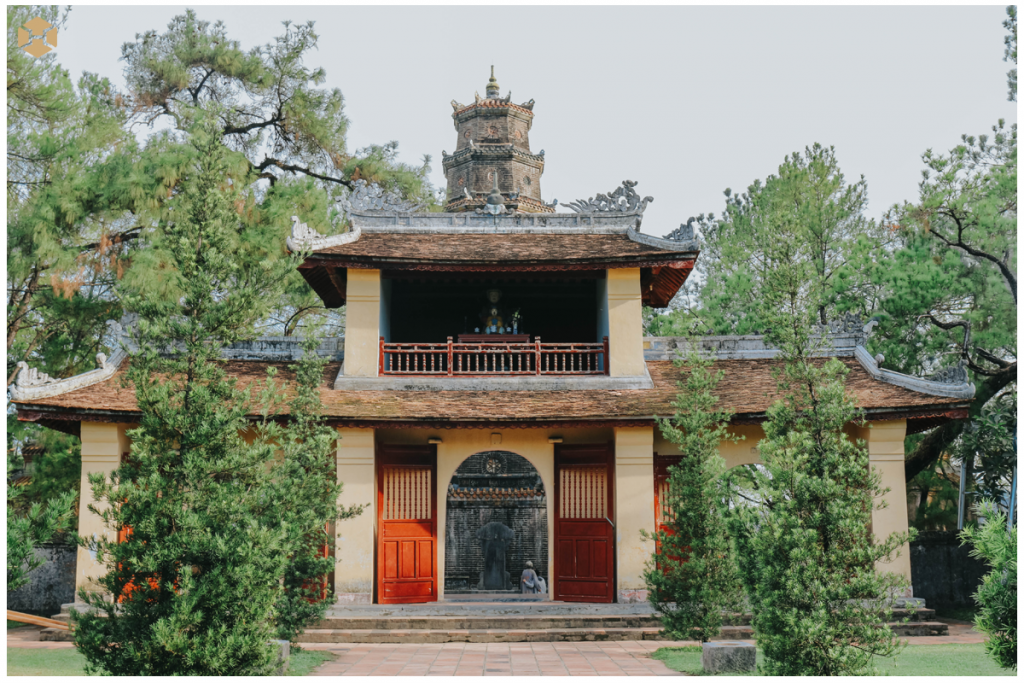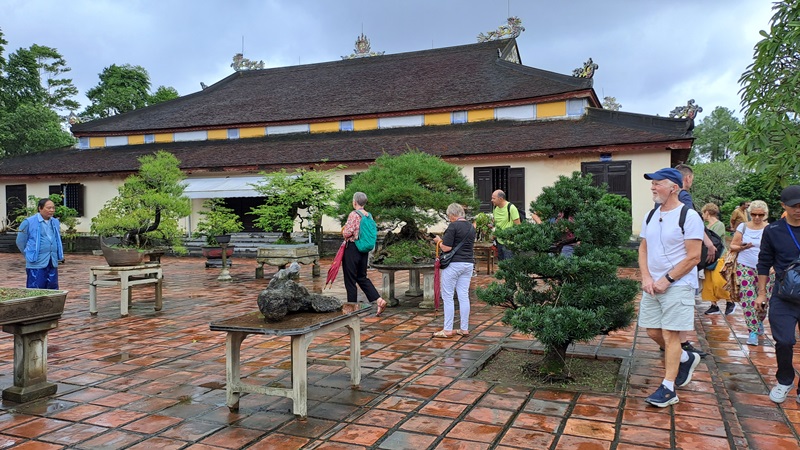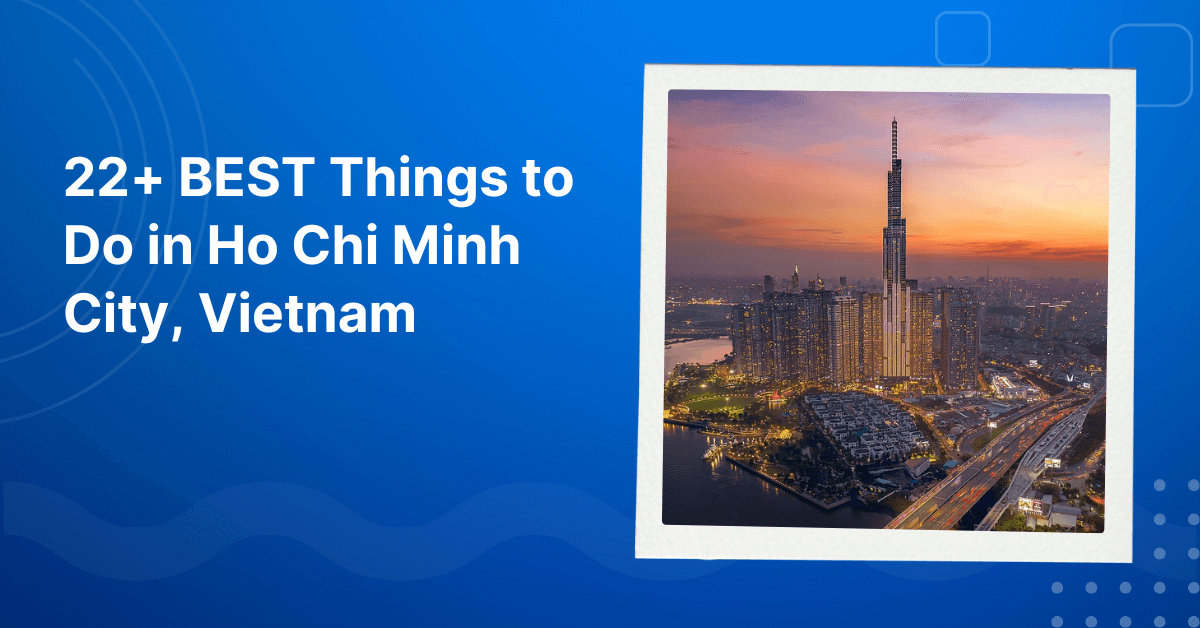Hue is well-known for its spectacular ancient architecture, attracting thousands of tourists worldwide to pay a visit every year. Thien Mu Pagoda is a destination not to be missed for tourists who want to learn more about spiritual enlightenment and cultural integration. Let’s explore Thien Mu Pagoda with VTJ in the article below.

Thien Mu Pagoda is distinctive for its spectacular ancient architecture
An Overview of Thien Mu Pagoda, Hue
Thien Mu Pagoda or Linh Mu Pagoda is situated on Ha Khe Hill, about 5 kilometers southwest of the city center of Hue. It is located in An Ninh Thuong village, Kim Long ward, Hue city, Thua Thien Hue province.
- Thien Mu Pagoda entrance fee: free
- Thien Mu Pagoda opening hours: all day
>>>Read more: 15+ Famous traditional craft villages in Vietnam you should visit
>>>Read more: Places you must see in the North of Vietnam
How to Get to Thien Mu Pagoda, Hue
There are many choices for visitors to come to Thien Mu Pagoda, it can be rented motorbike or bicycle, cyclo or taxi.
- Bicycle: Cycling to Thien Mu Pagoda can be a fascinating experience. This means of transportation takes about 40 minutes to arrive at the pagoda.
- Motorbike: You can rent a motorcycle and take the following route if you want to go by yourself. It is about 2 kilometers to ride along Kim Long Street from the Imperial City of Hue to Thien Mu Pagoda. Ten to fifteen thousand VND a day is the rental fee for a motorbike.
- Boat: If you want to immerse yourself in the breathtaking landscape along the riverbank, you should take the dragon boat. It will take 30 minutes to get to Thien Mu Pagoda.
- Cyclo: A cyclo is a traditional Vietnamese three-wheeled bicycle taxi, getting to Thien Mu Pagoda by this vehicle can be a wonderful experience. Visitors can catch a cyclo to admire the peaceful scenery and enjoy the atmosphere.
- Taxi: The fastest way to come to Thien Mu Pagoda is to take a taxi. It is easy to find a taxi in Hue City.
>>>Read more: Marble Mountains: A stunning natural wonder in Danang
The Best Time to Visit Thien Mu Pagoda, Hue
February to April and September to November, which are regarded as Hue’s busiest travel seasons, are the ideal times to visit Thien Mu Pagoda. From February to April, the weather is very nice, and a little light rain. You can enjoy red phoenix flowers blooming if you travel to Thien Mu Pagoda.
 The red phoenix flowers blooming at Thien Mu Pagoda
The red phoenix flowers blooming at Thien Mu Pagoda
>>>Read more: What you should know when traveling by road in Vietnam
History of Thien Mu Pagoda, Hue
The pagoda’s origins can be traced back to 1601 during the reign of Lord Nguyen Hoang, the founder of the Nguyen Dynasty. Legend has it that a local woman had a dream in which a celestial lady appeared and foretold the construction of a pagoda on the hill where the pagoda stands today. Following this auspicious dream, Lord Nguyen Hoang ordered the construction of the Thien Mu Pagoda.
>>>Read more: Visiting Halong: a guide to the basics of this beautiful city
Architectural Highlights of Thien Mu Pagoda, Hue
1. Tam Quan Gate
The entrance to Thien Mu Pagoda is marked by a grand gate decorated with vibrant colors and intricate patterns. The gate features traditional Vietnamese architecture and serves as a welcoming entrance for visitors. From a distance, the three-story gate resembles an old tower. The middle layer is circular, the top floor is square, and the lowest floor is a triangle.

Distinctive patterns on Tam Quan Gate
>>>Read more: 8 experiences worth trying when traveling to Hue city
2. Dai Hung Palace
This is the main prayer hall of Thien Mu Pagoda. It is a beautifully decorated building with a curved roof and intricate woodwork. Inside the hall, visitors can find statues of Buddha and other significant figures in Vietnamese Buddhism.
3. Phuoc Duyen Tower
The seven-story octagonal tower, also known as Thap Phuoc Duyen, is the most iconic feature of Thien Mu Pagoda. Each floor is dedicated to a different Buddha and is decorated with intricate carvings and statues. The tower’s height and elegant design make it a prominent landmark in the area.
>>>Read more: Top 5 best nature attractions in Danang
4. Dia Tang Palace
Dia Tang Palace is right behind Dai Hung Palace. In this place, you can get a sense of serenity and calmness. Dia Tang Palace has a large yard in front with a green lake and grass. Additionally, the location of God worship is located on both sides of the palace; there are ten gods on each side.
5. Tomb of Venerable Thich Don Hau
Venerable Thich Don Hau is a well-known abbot in Thien Mu Pagoda, who devoted all his life to contributing to the development of Buddhism in Vietnam. In addition, he also took part in a significant deal of community service and public work, which helped him gain the respect of the general population. Therefore, to show their deep thanks to the esteemed monk, residents, and pagoda administrators buried the Venerable under the tower at the end of the campus when he died away.
>>>Read more: Traveling in Vietnam- all big cities
What are the Thien Mu Pagoda Dress Code And Other Notes?
This is a religious site, so visitors should wear respectfully to show respect for the local culture and beliefs. It can be trousers or clothes covering your shoulders and knees. And remember to take off your shoes before entering the main hall.

Visitors travel to Thien Mu Pagoda.
Ending
Thien Mu Pagoda is always a must-visit place where tourists can treat their eyes to the unique religious architecture of the Nguyen Dynasty. VTJ hopes this article will help you have a deep knowledge about this wonderful Pagoda.
>>>Read more: 3 hundred-year-old craft villages in Hoi An you should know
Are you facing difficulties in finding and securing teaching positions in Vietnam? Are visa procedures causing you trouble? Feeling overwhelmed and directionless upon your arrival in Vietnam for teaching assignments? Don’t worry, VTJ’s English Teaching Placement in Vietnam (EPIV) Program 2024 provides comprehensive support to solve ALL the matters.
👉👉👉 Click HERE to request free consultation




